Wheeler & Wilson "Number 8"
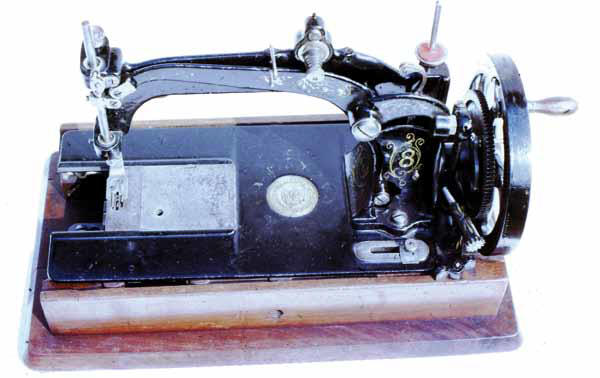
No. 8 hand machine with geared drive from the flywheel.The Number 8 Manual
by Martin Gregory
ISMACS News 106
March 2012
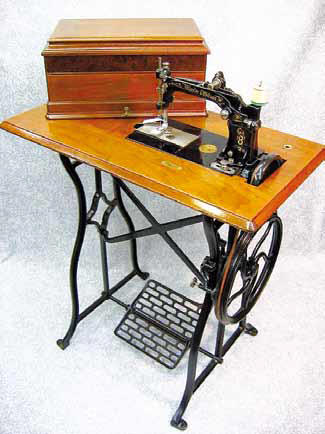
The No. 8 as a treadle machine.
By 1875, the Wheeler & Wilson Company were falling down the rankings, having been overtaken by the Singer Manufacturing Co. as the largest producer of sewing machines.
For the domestic market, their only offering was the curved needle machine which was launched in the 1850s and had not changed since the mid- 1860s. Although this machine continued to sell well as a treadle machine and to be cloned widely in Europe, it had several disadvantages. No successful hand version was developed; the few hand machines which survive are awkward to use with the winding handle underneath the emerging seam and the sewing area so high above the table. On the technical side the 'disc' bobbin held very little thread. In making the stitch the hook has to draw out a much larger loop to pass round the bobbin, than the loop spread by the nose of a shuttle.
This caused take-up problems with the coarse non-uniform thread of the period.
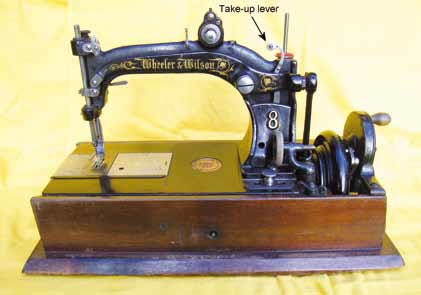
The usual No. 8 hand machine with separate hand winder.
The Singer 12 or 'New Family' machine had been around for ten years in 1875, as had the 'Mack', the prototype 'high-arm' vibrating shuttle machine which developed into the 'Domestic' and many others. Wheeler & Wilson needed a new machine to regain their market position, a machine which was a quantum leap beyond their current machine whilst still remaining faithful to the rotary hook principle. The engineer behind this replacement was James Alford House and the resultant machine was called the 'Number 8'.

The glass presser foot of the No. 8 with feed dog either side of the needle.
House drew on his earlier patents for rotary hook machines to produce the 'Number 8' in 1876. The master patent, 175463, was filed on March 28th 1876. It addressed all the weaknesses of the curved needle machine and gave Wheeler & Wilson a top rank rotary hook machine for domestic and light industrial use. Let us see how he solved these problems.
The No. 8 used a smaller diameter but much fatter bobbin which held a lot more thread. The bobbin was mounted in a case which enabled an underthread tension to be included (missing on the old machine).
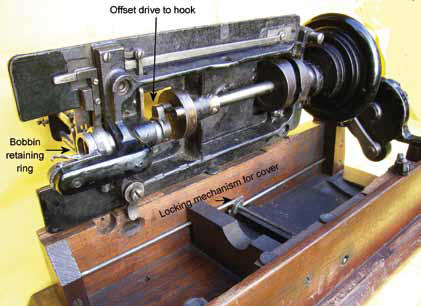
Underside of the Number 8 head.
When sewing slowly, the old hook could sometimes fail to pick up the loop (dropping the stitch) and, when stitching rapidly, the loop was cast off and failed to tighten. This second failing was addressed by the 'check brush' which retained the loop until pulled tight by the next stitch. The No. 8 solved this problem by arranging that the hook shaft did not line up with the main shaft of the machine. This offset resulted in the hook speeding up as it picked up the loop and slowing down as it was to cast it off. Early machines also had a steel spring latch to retain the loop.
The decoration of the machine was austere; Wheeler & Wilson placed a brass medallion in the centre of the base with little further decoration around it. I was told that they only used decoration on the overarm, since decoration on the base soon got scratched so that it looked better without it! The treadle version of the No. 8 was available on a simple table and in full cabinets. The hand machine had a robust cover with a complicated 4-pin locking system.
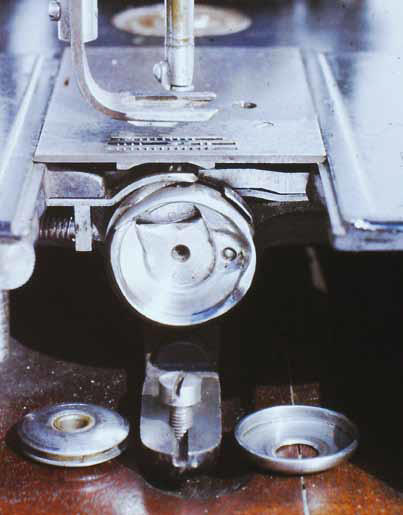
The latched hook and bobbin case of the early No. 8.
In Europe, just as the curved needle machine had been widely cloned or made under licence, so was the No. 8.
I have never seen an English clone but Baer & Rempel and other German manufacturers made clones of the No. 8.
In the 1890s, long after the No. 8 was out of production in the US, Hurtu introduced their Model A which had the same take-up and offset drive to the rotary hook as the No. 8, producing a French version of the design.
The No. 8 was also the first machine with a positive take-up. Its competitors relied on a spring, or a sprung lever, to pull the stitch tight after the shuttle had passed through the loop of thread. The take-up on the No. 8 was driven from a cam on the main shaft to pay out exactly the correct length of thread to form the loop and then, when the loop was cast off, to pull in the correct length of thread. This made an enormous difference to the uniformity of the stitching. Also the thread path went around small pulleys rather than guide holes, so that roughness of the thread did not affect the stitching.
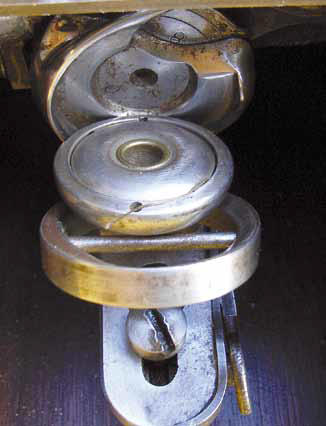
The usual form of hook withcased bobbin and retaining ring.
With the launch of the No. 8, Wheeler & Wilson had the first really modern rotary machine which rapidly became the market leader. It was available as both a treadle and a hand machine. The early hand gear was an integral gear drive from the flywheel and the later ones had a 'Singer-like' hand gear driving the standard balance wheel of the treadle machine.
By the mid 1880s, the No. 8 had been in production for ten years and was beginning to look old fashioned with its exposed upper works and all the shafts below the tabletop. Singer had produced the IF (later class 15) with its oscillating shuttle and cased round bobbin. The IF was capable of high speeds with little vibration and, along with all the rest of the competition, featured a high arm with the main shaft and balance wheel in the overarm above the base.
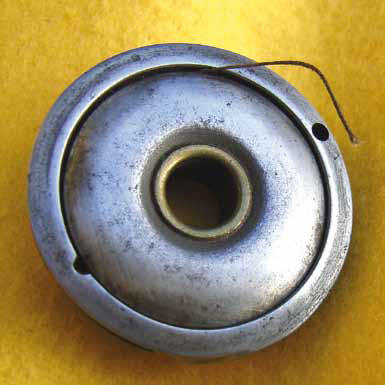
The No. 8 bobbin in its case.
A reworking of the No. 8 mechanism evolved into the D9, one of the all-time greats. The D9 featured the cased bobbin, positive take-up and the non-uniform rate of rotation of the hook from the No. 8. This last came from the sliding pivot, part way along the connecting rod between the upper and lower shafts. rather than an offset between the hook shaft and the main shaft. MG

J.A. House's patent 175,463 of March 29, 1876 for the W&W No.8





